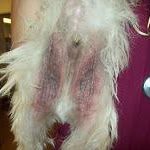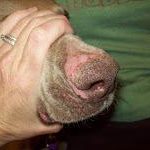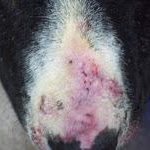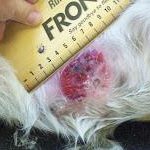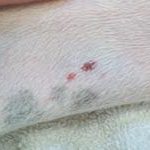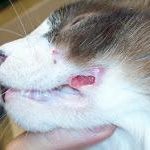Here in the desert we see a lot of sun induced skin disease and cancer in animals just as we do in people. Keeping your pet indoors or in a shaded area is the best way to avoid sun damage. When they are outside you can keep them covered with a UV protected shirt or use sunscreen on exposed areas.
There are a number of factors that may make your pet more susceptible including breed, hair coat, pigmentation and amount of time outside. Some pets like to “sunbathe” and expose their bellies to the sun and these pets seem to be particularly sensitive.
Any of our light coated dogs but especially Boxers and Pitbulls seem to have an increased incidence of skin cancers. Dogs and cats that have pink noses and pale eyelids are more prone to cancer in these non-pigmented areas. Pets who have suffered hair loss from allergies, hot spots, disease, surgical preparation, or radiation can benefit from sunscreen. Don’t forget that if you give your pet a “summer hair cut” that their newly exposed skin will be very sensitive.
In pets, sunburn can appear as red skin or hair loss. The photo below shows sunburn on the nose. Sunburn can irritate or exacerbate existing conditions, such as allergies or hot spots. The dog on the left has discoid lupus which is an autoimmune disease however the sun exposure on the raw, damaged skin can make this disease even more painful and difficult to control. If your pet has a non-healing scaly patch, dark red or purple raised lesions on the skin or black, irregular freckles, these lesions should be looked at by your veterinarian.
Sunscreen can be applied to the bridge of the nose, ear tips, skin surrounding the lips, and any area where pigmentation is low. The sunscreen should be fragrance free, non-staining, and contain UVA and UVB barriers similar to SPF 15 or SPF 30 for humans. (SPF labeling and claims are not permitted in products marketed for use on pets, however, because the FDA has not established a test to determine SPF values in pets.) Some protective ingredients include Ethylhexyl Methoxycinnamate, Octyl Salicylate, Homosalate and Benzophenone-3. Octyl Salicylate products should not be used on cats. Avoid zinc oxide as this can be toxic if ingested as well. I like the non-greasy spray formulas. They are more quickly absorbed and tend not to stain furniture or clothing.
There are some sunscreens created specifically for pets, but using children’s sunscreen is also an option. Most human sunscreens have ingestion warnings because the ingredients can be toxic if a child or dog ingests them, so if your pet is likely to lick it, look for a pet-specific sunscreen. Doggles has an SPF 15 spray sunscreen. Nutri-Vet offers an SPF 15 sunscreen both in a lotion form and a spray. Epi-Pet Skin Care Line has just introduced Epi-Pet Sun Protector. It’s labeled for use in dogs and horses and all animals except cats and has SPF equivalency of 30-40
One thing to remember about sunscreen is that you need to use plenty of it, and you should re-apply regularly during sun exposure. It is recommended to use at least 1 tablespoon of lotion or cream for each body area treated! Sunscreen should be re-applied every 4 to 6 hours during the brightest time of the day from 10 a.m. to 3 p.m
If you have a pet that spends most of his time outdoors, consider a UV protective sunsuit. Designer Dogwear makes male and female dog suits to help protect the skin on their trunk. Tuga makes UV t-shirts and hats for dogs as well.
Photos: (from left to right)
1: belly showing signs of chronic sunburn
2: discoid lupus
3: solar dermatitis
4: skin on belly with squamous cell carcinoma
5: cutaneous hemangiosarcoma on a white boxer
6: basal cell carcinoma on the face
What's Next
Call us or schedule an appointment online.
Meet with a doctor for an initial exam.
Put a plan together for your pet.


